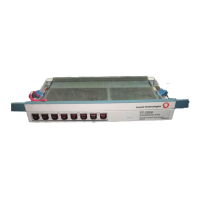Control, Transmission, and Synchronization Interfaces
5-10 Issue 8.0 July 2002
Synchronization Modes 5
Platform Synchronization 5
General 5
The FT-2000 OC-48 Lightwave System platforms can be provisioned for the
following synchronization modes:
■ FT-2000 OC-48 Add/Drop-Rings Terminal
— Free running from an internal oscillator
— Through timed from an incoming OC-48 signal
— Line Timed using sync-messages that are derived from the
incoming OC-48 signal (Release 7.2.0 and later software)
— Externally timed (phase locked in releases prior to Release 5) to
the digital synchronization network using DS1 synchronization
references (external timing)
NOTE:
The Release 7.1 generic software provides "Sync Messaging".For
those OC-48 rings that connect to other rings (including a DDM-2000
ring) — this feature may be used to enhance network
synchronization. More specifically, R7.1 supports messages STU,
ST3 and DUS on the OC-48 and these messages are sent out on the
OC-3 and OC-12 K-bytes on a provisionable basis.
■ FT-2000 OC-48 Repeater Bay
— Through timed from an incoming OC-48 signal.
As network needs evolve, the FT-2000 OC-48 Lightwave System can be
reprovisioned easily in service to change synchronization modes as needed. If the
synchronization mode is reprovisioned to the externally timed mode (phase
locked mode in releases prior to Release 5), external DS1 synchronization
references are required.
The FT-2000 OC-48 Lightwave System also provides DS1 synchronization output
signals to the office building integrated timing supply (BITS) clock or other central
office equipment.
Internal timing functions—reference interfaces, the on-board clock elements, and
timing distribution—are located on the Timing Generator, Stratum 3 - DS1
[TG3 (DS1)] circuit packs. The TG3 (DS1) circuit packs distribute clock signals
derived from the selected reference source to the transmission circuit packs.

